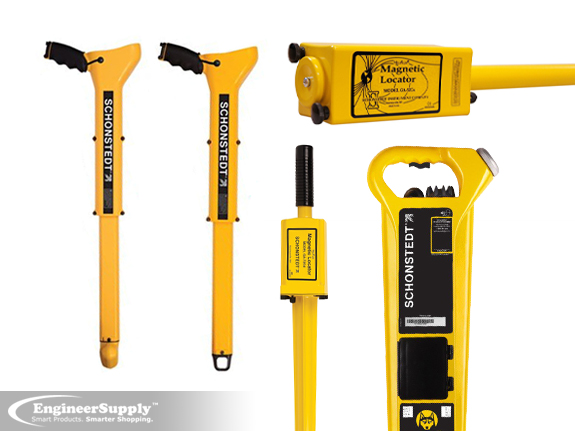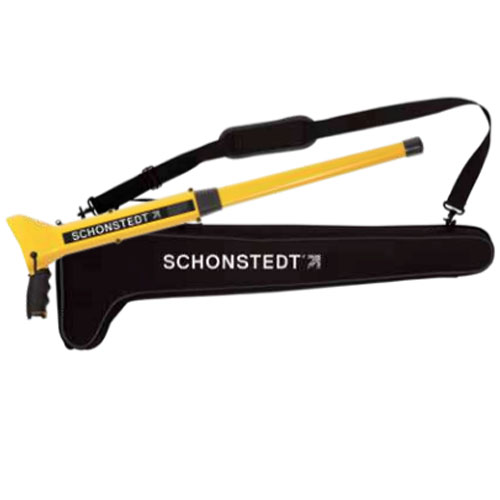 The Schonstedt Instrument Company provides solutions for the detection and location of ferrous objects and utilities below the surface of the ground or water. Founded in 1953, the Schonstedt Instrument Company designs and manufactures instruments for location of underground objects. Schonstedt offers both pipe and cable locators and magnetic locators.
The Schonstedt Instrument Company provides solutions for the detection and location of ferrous objects and utilities below the surface of the ground or water. Founded in 1953, the Schonstedt Instrument Company designs and manufactures instruments for location of underground objects. Schonstedt offers both pipe and cable locators and magnetic locators.
The purpose of this article is to briefly explain the differences in each Schonstedt Underground Locator model, and the features they offer.
First, we'll mention that they're all called "Underground Locators". Some people call them Utility Locators, Yellow Sticks, or sometimes Metal Detectors. Schonstedt Instrument Company basically makes two different types of Underground Locators. The first is a "Magnetic Locator", and the other is a "Pipe and Cable Locator". We will explain the basic differences and how they work in this article. This will allow you to hopefully learn more about the differences in the various models and figure out which model best suits the tasks that you'll use your Underground Locator for.

Magnetic Locators
You'll need to understand that Magnetic Locators will ONLY locate metal objects that are made of ferrous material. Basically speaking, if a magnet will stick to it, a Magnetic Locator will detect it. Please understand that how deep in the ground you can detect something depends on it's mass. A surveying nail you can find up to about 2, maybe 3 feet. An underground storage tank you can find up to about 15 to 17 feet deep. Magnetic Locators will not detect objects such as electrical power cable made of aluminum or copper since these materials are not considered ferrous. Items that are found using Magnetic Locators are usually, cast iron pipes, property corner markers, steel enclosures or hardware, hazmat drums, mag and pk nails, manhole covers, marker magnets, septic tanks, unexploded ordnance, valve boxes, weapons, and well casings.
Pipe and Cable Locators
With Pipe/Cable Locators, they do NOT detect metal objects like a magnetic locator does. A Pipe/Cable Locator will ONLY locate objects that have some type of charge or signal placed on them. Many utilities give off or transmit a signal of their own that is sometimes detected by a Pipe/Cable Locator such a 60Hz for live for power lines. But, sometimes the person doing the locating must induce a signal onto the line in order to be able to locate it. Most Pipe/Cable Locators have the ability to induce a signal onto an object (like a waterline) using a Transmitter, and the object must be metallic in order to conduct the signal. Pipe/Cable Locators typically come with a receiver and a transmitter but not always. It depends on the model you purchase. Some models come with a portable pocket-sized transmitter with limited features, and some come with standard transmitters that are built into a hard case and offer more features for varied situations. To simply describe how a Pipe/Cable Locator works, the transmitter is just like a radio station that's putting out a signal, and to pick up the radio station you want to listen to (for example your favorite rock music station) you need a receiver. Just like radio stations, the transmitters transmit signals at certain frequencies. Some Pipe/Cable Locators come from the factory with multiple signals to choose from, and some come from the factory with a single frequency that you decide and select before the purchase. To induce a signal onto a pipe or cable, the Transmitter along with Signal Clamps or Alligator Clips that you place or fasten around on onto pipe, fire hydrants, cables, and other utilities or lines that you're wanting to locate. When accessibility to the utility’s
end-points (above ground) are not known, the transmitter can also induce a signal from above, through the ground to reach the utility. This allows the Transmitter to send it's signal onto the pipe or cable you're wanting to locate. Some Pipe/Cable Locator models come with the accessories like Signal Clamps and Alligator Clamps or Inductive Antennaes, and sometimes you have to purchase the accessories separately. Items that are found using Pipe/Cable
Locators are usually cable TV lines, fiber optic lines with a metallic conductor alongside, irrigation lines, plastic pipe or conduit (plastic pipe can be located by inserting a sonde or mini-transmitter and locating the sonde), plastic pipe tracer wire, power lines, street light power, and water lines.
Now hopefully you have a better understanding of how a Magnetic Locator, and a Pipe-Cable Locator works.

Great Selection of Magnetic Locators
Shop from top brand names today! Find professional-grade Magnetic Locators used for locating land survey markers, ductile iron water lines, and survey monuments.
SHOP MAGNETIC LOCATORS
Underground Locator Model Suggestion
Hopefully this will help you quickly figure out
which model is suggested for the job. It basically depends on what you want to accomplish with your new
Underground Locator, so start out by asking yourself and your co-workers, exactly what do you want to accomplish with an Underground Locator.
| |
Magnetic
Locators |
|
| |
Schonstedt Magnetic Locator GA-52Cx
This is the work-horse model. It has audio
only, as it does not have a visual display. It's
the most popular selling model.
Schonstedt Maggie
Ergonomic, pistol grip handle. Battery
compartment is located on the handle for
ease of battery changes in the field.
Display has sensitivity and volume
adjustments. Comes with a soft case and
strap.
Schonstedt Magnetic Locator GA-72Cd
This model is the same as the GA-52Cx only it has a
handle, audio, sensitivity adjustment, as well as an LCD visual display,
which displays polarity and signal strength.
The display helps define the outer edges of
the target.
Schonstedt Magnetic Locator GA-92XTd
This model has an expanding and
retractable body. Makes it easier to carry
in the field, and easier to store in small
places (behind your truck seat for example).
This model has an LCD visual display which
displays polarity, sensitivity, and signal strength. The
display helps define the outer edges of the
target.
Schonstedt Magnetic Locator GA-92XTi
This model has an expanding and
retractable body. Makes it easier to carry
in the field, and easier to store in small
places (behind your truck seat for example).
It has audio with sensitivity and volume
controls.
Schonstedt Magnetic Locator MAC-51Bx
This model has been discontinued and is no longer available. |
|
| |
|
|
| |
Pipe and Cable
Locators |
|
| |
Schonstedt XTpc Pipe and Cable Locator
This is the most portable Pipe & Cable
Locator as it has an expanding and
retractable body. It comes with a
pocket-sized Trasmitter. It is made in two
frequencies. You select a single frequency
before purchase (either 33Khz or 82 Khz).
Great for rural and less congested areas.
Schonstedt XTpc+ Pipe and Cable Locator
The newest model of Pipe and Cable Locators that offers 3 frequencies
(512Hz, 33Khz and 82Khz). Has adjustable
watts (from .5 to 5) for pushing the signal
further distances. Great for use in very
congested areas. The XTpc+ is the replacement for the Schonstedt TraceMaster.
The Schonstedt TraceMaster is no longer available.
Schonstedt XT 512
Can only be used to find sondes and
inspection cameras. The operating frequency
of this unit is 512HZ.
|
|
Copyright 1999-2015 EngineerSupply.com

Frequently Asked Questions
How does a Schonstedt underground locator work?
The Schonstedt magnetic locator can be used for finding utility lines and magnetic pipes, which is an important first step for any type of excavation and drilling project. A magnetic locator can only be used to find ferrous metals, which are materials to which a magnet will stick. So if you need to find a PVC pipe as well as any other type of non-magnetic or non-metallic object, you will need to use a pipe and cable locator that allows you to transmit a specific frequency that the instrument will be able to detect.
How much does a Schonstedt locator cost?
You can purchase a Schonstedt GA-52Cx Magnetic Locator at Engineering Supply for $769, but we have Schonstedt locator tools that go for a little as $300 to as much as $3,500. Be sure to look at what we have in stock, so you can find a Schonstedt magnetic locator that’s right for you!
What is the best Schonstedt underground utility locator?
The Schonstedt GA-52Cx
Magnetic Locator can be used to find objects that are made of ferrous metals. But if you want to find any type of non-metallic piping or any object that’s made of any non-magnetic metal, you will need to use some other type of Schonstedt locator — one that can detect a specific frequency you can transmit through the utility line.
How do I find an underground PVC pipe?
While there are many other methods for finding PVC pipelines, the easiest way is to use a pipe or cable locator that can transmit a specific radio frequency through the line you want to detect. Be sure to look at what we have at Engineering Supply, so you can find a Schonstedt locator or any other type of location device that will meet your specific needs.
Can a Schonstedt underground locator find copper pipes?
Television cables, phone lines, electrical cables, and electrical wires run underground. And other utility lines (including water, sewer, and gas lines) can be made of copper as well. Modern pipe installations should have a copper wire attached to the underground line, which can be used for location purposes. But older installations may not have this type of marking wire. To find copper wire, you will need to use an underground wire locator that can detect this material.
If you’re looking for a Schonstedt magnetic locator or any other type of location device, be sure to look at what we have at Engineering Supply.